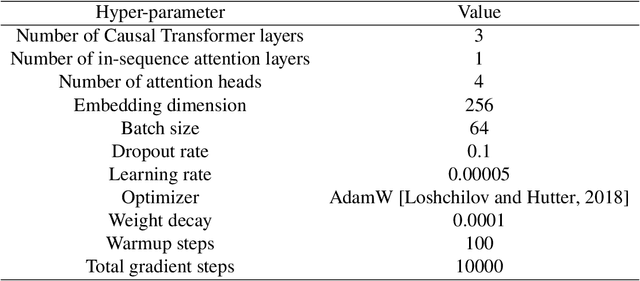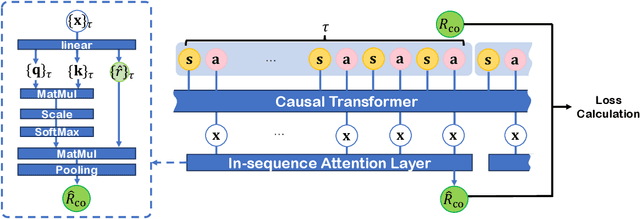Masashi Sugiyama
Tokyo Institute of Technology
Domain Adaptation and Entanglement: an Optimal Transport Perspective
Mar 11, 2025Abstract:Current machine learning systems are brittle in the face of distribution shifts (DS), where the target distribution that the system is tested on differs from the source distribution used to train the system. This problem of robustness to DS has been studied extensively in the field of domain adaptation. For deep neural networks, a popular framework for unsupervised domain adaptation (UDA) is domain matching, in which algorithms try to align the marginal distributions in the feature or output space. The current theoretical understanding of these methods, however, is limited and existing theoretical results are not precise enough to characterize their performance in practice. In this paper, we derive new bounds based on optimal transport that analyze the UDA problem. Our new bounds include a term which we dub as \emph{entanglement}, consisting of an expectation of Wasserstein distance between conditionals with respect to changing data distributions. Analysis of the entanglement term provides a novel perspective on the unoptimizable aspects of UDA. In various experiments with multiple models across several DS scenarios, we show that this term can be used to explain the varying performance of UDA algorithms.
Robust Multi-View Learning via Representation Fusion of Sample-Level Attention and Alignment of Simulated Perturbation
Mar 06, 2025



Abstract:Recently, multi-view learning (MVL) has garnered significant attention due to its ability to fuse discriminative information from multiple views. However, real-world multi-view datasets are often heterogeneous and imperfect, which usually makes MVL methods designed for specific combinations of views lack application potential and limits their effectiveness. To address this issue, we propose a novel robust MVL method (namely RML) with simultaneous representation fusion and alignment. Specifically, we introduce a simple yet effective multi-view transformer fusion network where we transform heterogeneous multi-view data into homogeneous word embeddings, and then integrate multiple views by the sample-level attention mechanism to obtain a fused representation. Furthermore, we propose a simulated perturbation based multi-view contrastive learning framework that dynamically generates the noise and unusable perturbations for simulating imperfect data conditions. The simulated noisy and unusable data obtain two distinct fused representations, and we utilize contrastive learning to align them for learning discriminative and robust representations. Our RML is self-supervised and can also be applied for downstream tasks as a regularization. In experiments, we employ it in unsupervised multi-view clustering, noise-label classification, and as a plug-and-play module for cross-modal hashing retrieval. Extensive comparison experiments and ablation studies validate the effectiveness of RML.
Accurate Forgetting for Heterogeneous Federated Continual Learning
Feb 20, 2025Abstract:Recent years have witnessed a burgeoning interest in federated learning (FL). However, the contexts in which clients engage in sequential learning remain under-explored. Bridging FL and continual learning (CL) gives rise to a challenging practical problem: federated continual learning (FCL). Existing research in FCL primarily focuses on mitigating the catastrophic forgetting issue of continual learning while collaborating with other clients. We argue that the forgetting phenomena are not invariably detrimental. In this paper, we consider a more practical and challenging FCL setting characterized by potentially unrelated or even antagonistic data/tasks across different clients. In the FL scenario, statistical heterogeneity and data noise among clients may exhibit spurious correlations which result in biased feature learning. While existing CL strategies focus on a complete utilization of previous knowledge, we found that forgetting biased information is beneficial in our study. Therefore, we propose a new concept accurate forgetting (AF) and develop a novel generative-replay method~\method~which selectively utilizes previous knowledge in federated networks. We employ a probabilistic framework based on a normalizing flow model to quantify the credibility of previous knowledge. Comprehensive experiments affirm the superiority of our method over baselines.
Label Distribution Learning with Biased Annotations by Learning Multi-Label Representation
Feb 03, 2025Abstract:Multi-label learning (MLL) has gained attention for its ability to represent real-world data. Label Distribution Learning (LDL), an extension of MLL to learning from label distributions, faces challenges in collecting accurate label distributions. To address the issue of biased annotations, based on the low-rank assumption, existing works recover true distributions from biased observations by exploring the label correlations. However, recent evidence shows that the label distribution tends to be full-rank, and naive apply of low-rank approximation on biased observation leads to inaccurate recovery and performance degradation. In this paper, we address the LDL with biased annotations problem from a novel perspective, where we first degenerate the soft label distribution into a hard multi-hot label and then recover the true label information for each instance. This idea stems from an insight that assigning hard multi-hot labels is often easier than assigning a soft label distribution, and it shows stronger immunity to noise disturbances, leading to smaller label bias. Moreover, assuming that the multi-label space for predicting label distributions is low-rank offers a more reasonable approach to capturing label correlations. Theoretical analysis and experiments confirm the effectiveness and robustness of our method on real-world datasets.
Action-Agnostic Point-Level Supervision for Temporal Action Detection
Dec 30, 2024Abstract:We propose action-agnostic point-level (AAPL) supervision for temporal action detection to achieve accurate action instance detection with a lightly annotated dataset. In the proposed scheme, a small portion of video frames is sampled in an unsupervised manner and presented to human annotators, who then label the frames with action categories. Unlike point-level supervision, which requires annotators to search for every action instance in an untrimmed video, frames to annotate are selected without human intervention in AAPL supervision. We also propose a detection model and learning method to effectively utilize the AAPL labels. Extensive experiments on the variety of datasets (THUMOS '14, FineAction, GTEA, BEOID, and ActivityNet 1.3) demonstrate that the proposed approach is competitive with or outperforms prior methods for video-level and point-level supervision in terms of the trade-off between the annotation cost and detection performance.
Parallel simulation for sampling under isoperimetry and score-based diffusion models
Dec 10, 2024Abstract:In recent years, there has been a surge of interest in proving discretization bounds for sampling under isoperimetry and for diffusion models. As data size grows, reducing the iteration cost becomes an important goal. Inspired by the great success of the parallel simulation of the initial value problem in scientific computation, we propose parallel Picard methods for sampling tasks. Rigorous theoretical analysis reveals that our algorithm achieves better dependence on dimension $d$ than prior works in iteration complexity (i.e., reduced from $\widetilde{O}(\log^2 d)$ to $\widetilde{O}(\log d)$), which is even optimal for sampling under isoperimetry with specific iteration complexity. Our work highlights the potential advantages of simulation methods in scientific computation for dynamics-based sampling and diffusion models.
Beyond Simple Sum of Delayed Rewards: Non-Markovian Reward Modeling for Reinforcement Learning
Oct 26, 2024



Abstract:Reinforcement Learning (RL) empowers agents to acquire various skills by learning from reward signals. Unfortunately, designing high-quality instance-level rewards often demands significant effort. An emerging alternative, RL with delayed reward, focuses on learning from rewards presented periodically, which can be obtained from human evaluators assessing the agent's performance over sequences of behaviors. However, traditional methods in this domain assume the existence of underlying Markovian rewards and that the observed delayed reward is simply the sum of instance-level rewards, both of which often do not align well with real-world scenarios. In this paper, we introduce the problem of RL from Composite Delayed Reward (RLCoDe), which generalizes traditional RL from delayed rewards by eliminating the strong assumption. We suggest that the delayed reward may arise from a more complex structure reflecting the overall contribution of the sequence. To address this problem, we present a framework for modeling composite delayed rewards, using a weighted sum of non-Markovian components to capture the different contributions of individual steps. Building on this framework, we propose Composite Delayed Reward Transformer (CoDeTr), which incorporates a specialized in-sequence attention mechanism to effectively model these contributions. We conduct experiments on challenging locomotion tasks where the agent receives delayed rewards computed from composite functions of observable step rewards. The experimental results indicate that CoDeTr consistently outperforms baseline methods across evaluated metrics. Additionally, we demonstrate that it effectively identifies the most significant time steps within the sequence and accurately predicts rewards that closely reflect the environment feedback.
Sharpness-Aware Black-Box Optimization
Oct 16, 2024Abstract:Black-box optimization algorithms have been widely used in various machine learning problems, including reinforcement learning and prompt fine-tuning. However, directly optimizing the training loss value, as commonly done in existing black-box optimization methods, could lead to suboptimal model quality and generalization performance. To address those problems in black-box optimization, we propose a novel Sharpness-Aware Black-box Optimization (SABO) algorithm, which applies a sharpness-aware minimization strategy to improve the model generalization. Specifically, the proposed SABO method first reparameterizes the objective function by its expectation over a Gaussian distribution. Then it iteratively updates the parameterized distribution by approximated stochastic gradients of the maximum objective value within a small neighborhood around the current solution in the Gaussian distribution space. Theoretically, we prove the convergence rate and generalization bound of the proposed SABO algorithm. Empirically, extensive experiments on the black-box prompt fine-tuning tasks demonstrate the effectiveness of the proposed SABO method in improving model generalization performance.
On Unsupervised Prompt Learning for Classification with Black-box Language Models
Oct 04, 2024



Abstract:Large language models (LLMs) have achieved impressive success in text-formatted learning problems, and most popular LLMs have been deployed in a black-box fashion. Meanwhile, fine-tuning is usually necessary for a specific downstream task to obtain better performance, and this functionality is provided by the owners of the black-box LLMs. To fine-tune a black-box LLM, labeled data are always required to adjust the model parameters. However, in many real-world applications, LLMs can label textual datasets with even better quality than skilled human annotators, motivating us to explore the possibility of fine-tuning black-box LLMs with unlabeled data. In this paper, we propose unsupervised prompt learning for classification with black-box LLMs, where the learning parameters are the prompt itself and the pseudo labels of unlabeled data. Specifically, the prompt is modeled as a sequence of discrete tokens, and every token has its own to-be-learned categorical distribution. On the other hand, for learning the pseudo labels, we are the first to consider the in-context learning (ICL) capabilities of LLMs: we first identify reliable pseudo-labeled data using the LLM, and then assign pseudo labels to other unlabeled data based on the prompt, allowing the pseudo-labeled data to serve as in-context demonstrations alongside the prompt. Those in-context demonstrations matter: previously, they are involved when the prompt is used for prediction while they are not involved when the prompt is trained; thus, taking them into account during training makes the prompt-learning and prompt-using stages more consistent. Experiments on benchmark datasets show the effectiveness of our proposed algorithm. After unsupervised prompt learning, we can use the pseudo-labeled dataset for further fine-tuning by the owners of the black-box LLMs.
Vision-Language Model Fine-Tuning via Simple Parameter-Efficient Modification
Sep 25, 2024Abstract:Recent advances in fine-tuning Vision-Language Models (VLMs) have witnessed the success of prompt tuning and adapter tuning, while the classic model fine-tuning on inherent parameters seems to be overlooked. It is believed that fine-tuning the parameters of VLMs with few-shot samples corrupts the pre-trained knowledge since fine-tuning the CLIP model even degrades performance. In this paper, we revisit this viewpoint, and propose a new perspective: fine-tuning the specific parameters instead of all will uncover the power of classic model fine-tuning on VLMs. Through our meticulous study, we propose ClipFit, a simple yet effective method to fine-tune CLIP without introducing any overhead of extra parameters. We demonstrate that by only fine-tuning the specific bias terms and normalization layers, ClipFit can improve the performance of zero-shot CLIP by 7.27\% average harmonic mean accuracy. Lastly, to understand how fine-tuning in CLIPFit affects the pre-trained models, we conducted extensive experimental analyses w.r.t. changes in internal parameters and representations. We found that low-level text bias layers and the first layer normalization layer change much more than other layers. The code is available at \url{https://github.com/minglllli/CLIPFit}.
 Add to Chrome
Add to Chrome Add to Firefox
Add to Firefox Add to Edge
Add to Edge